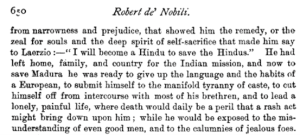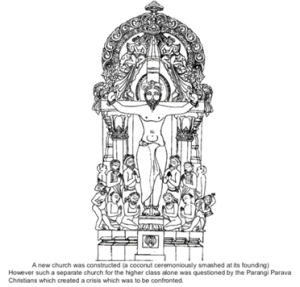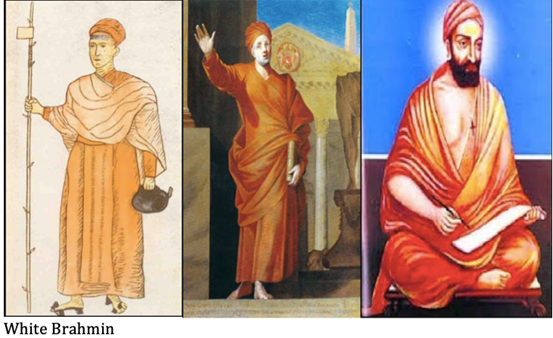by Unapologetic Hindu November 24, 2020
The man who first started the appropriation of Dharma IP
Modern day Christian missionaries are very well known for culture appropriation. But do you know that it is not a new concept? Christian missionaries who entered India during the 16th and 17th century appropriated Sanatana Dharma culture, language and way of living to gain more followers for the Church. They used deceit to trick people both from lower and upper castes.
While the British like to gloat they ‘civilised’ Indians and removed social evils such sati, and child marriage, they never bothered to remove the biggest social evil-caste. Caste is a concept imposed on Indians first by the Portuguese and then the British and has no mention in any Hindu scriptures. All missionaries who came to India came with only one intention – convert Hindus to Christianity.
One such missionary who came to Indian shores was Roberto De Nobili. Roberto De Nobili was born in an Italian Noble family in 1577. He abandoned his family’s dream of joining the Catholic Church and instead joined the Society of Jesus. He arrived in India, post-Portuguese conquest of Goa, which was on a conversion spree. He saw that the Christian converts were in name only and did not pursue Christianity actively. Most converts were asked to eat and dress like their Colonialists. Conversion was looked at as cultural domination, which Hindus resented. Also, most of the converts were low caste fisherman and natives who were not too keen to follow Christianity. During his interactions with the natives he came across Brahmins.
Nobili admired Brahmins for their social status and austere life. He aspired to convert them than the people from lower caste. Since he belonged to a noble family back home, he self-declared himself as a Brahmin and because of his determination to enter the Brahmin stronghold for conversion, he adopted their way of living and eating habits. He defended his act saying, “I will become a Hindu to save the Hindus”. Nobili started dressing as a Sanayasi, donning saffron robes, wore wooden shoes, carried a stick and water jug. He gave up eating meat, and drinking wine and stopped wearing leather goods. As foreigners were considered as ‘Parangis’- a derogatory term for white people, who ate beef, drank, wore leather, bathed irregularly and ignored the rules of social interaction. Parangis were despised for their uncouth and uncultured behaviour and their proselytes. He even shaved his head, leaving just a tuft and applied sandalwood paste on his forehead. He engaged a Brahmin cook and ate only rice, vegetables and lentils, and slept on the floor. He kept his distance from lower-caste people to avoid ‘pollution’. He even wore the sacred thread with three strings. Nobili justified his actions by calling it the Holy Trinity: the Father, Son and the Holy Spirit.
When his Superiors in his Church questioned his actions, De Nobili defended them saying these Brahminical symbols were mere symbols and an attestation of his superior birth. He claimed these were required to win over the Brahmins who were proving to be quiet a challenge.
During this time, he set up an “ashram” in the outskirts of Madurai where he learned Tamil, Telugu and Sanskrit under the tutelage of Sivadharma. Nobili studied the Vedas and Upanishads. Thus, Nobili is alleged to be the first European to ‘master’ Sanskrit. He wrote Christian psalms and prayers in Tamil. He started calling the Bible as “Vedam”, Church as “kovil” (temple), blessing as “Arul”, grace as “Prasadam” (Prasad), Priest as “guru”, and mass as “poosai” (pooja). He composed Christian hymns and songs in Tamil and set them to Hindu devotional music. The songs and hymns were used for sacraments, which he called them “Samskaras” at the time of birth, death and marriages. Native festivals were Christianised. Nobili gave converts Christian names that were translated into Tamil. Native Hindus were oblivious to the deceit of De Nobili and were unaware that they now belonged to another faith. He started calling him self an “Iyer” where local people venerated him for an austere life. It is alleged he had acquired moderate healing powers. There is no evidence of this.
This deceit won him success eventually. He was successful in converting more than 100’s of people into Christianity including Sivadharma, his Sanskrit teacher and gave him the name ‘Albert’. Nobili was also successful in converting Sivadharma’s brother and was named Francis. The ruling Nayak family of Madurai too had few converts that included Alexis Nayak, and Ignatius Nayak.

The Brahmins converts were allowed to retain their Brahminical symbols. But the Brahmin converts refused to attend mass with their lower-caste converts. To solve this problem, De Nobili made a Brahmin church just for upper caste converts. He even built churches modelled like Hindu temples and had gained a very good following among the natives. Meanwhile, his alleged “healing powers” started gaining prominence. He cured the royal members of Salem and converted them to Christianity. This earned the ire of the locals who were angry at the deceit of De Nobili.
As Nobili gained more knowledge in Sanskrit and Tamil, he opened a school of catechism and introduced Christian theology. He built a church on the site granted to him by cousin of the King of Madurai.
All of this trickery eventually caught the eye of Pope Gregory XV in 1610 and instituted a secret Tribunal to deal with several complaints against De Nobili’s approach to evangelisation of native Indians. Peter Lombard, a learned member of the Tribunal studied the case and arguments put forth by De Nobili and convinced the pope that this was a novel method to bring more followers to the Church. After a struggle of thirteen years, the Vatican agreed to localization of several modes of preaching in Eastern and African countries.

As his methods were approved in 1623, De Nobili began to establish Church centres beyond Madurai, beginning with Tiruchirapalli and Salem. This resulted in people from different backgrounds embracing Christianity. Brahmin church had ‘sanyasis’ who would look after the spiritual needs of Brahmins. They would observe the strict lifestyle as that of Brahmins–had to be Sanskrit scholars, strict vegetarians, etc. ‘Pandarasamis’ on whom no restriction was placed served the lower caste converts. As the years went by Pandarasamis were lot more successful than Brahmin Sanyasis in their conversion efforts. This resulted in dwindling of Brahmin Sanyasis to negligible numbers. A total of 122 “missionary sanaysins” followed the De Nobili method of conversion before the Jesuit order was suppressed in 1773.
Father Balthasar de Costa of Society of Jesus was the first Pandarasami followed by Fathers Alvarey, Prosena, Freie, Britto Bonchet, Laynes, Beschi and many more. He and his followers faced immense opposition from Hindus many times. As the truth of his antecedents caught up with him, his long line of converts dried away in no time. De Nobili appealed to his followers in Europe in an Annual Letter in 1651 to procure an ointment that would change colour of his skin permanently: “It is not necessary that the colour should be very dark; the most suitable would be something between black and red or tawny.”
The Church glorifies the numbers of converts by De Nobili but the truth is majority of Hindus weren’t fooled by his deceit. Unfortunately, post-independence multiple generations of Hindus are not aware of this deceit by the Church and it’s missionaries. This information has either been deliberately left out or to cover-up the existent of deceit. Tamil Nadu government till date lists Roberto De Nobili as a Sanskrit, Tamil and Telugu scholar. Many books are written on his ‘understanding of Hindu culture’ and sadly is a highly revered figure in the State.
Today there are eight schools in Jharkand that bear De Nobili’s name. A Telugu novel by the name ‘Ekaveera’ was written by Janapith Award winner Viswanatha Satyanarayana. In this book the main character. ‘Tattvabhoodhaka Swami’, is based on the life of Roberto De Nobili.
CONCLUSION: The Church and their representatives used Brahmins to deceive and convert natives in 1600’s and 1700’s, later it was this very Brahmin community who refused to convert, were vilified and an entire movement for their ouster was led in 1960’s under the leadership of Periyar. Till this date ‘Brahimisim’ is used as a derogatory and castitiest slur and Brahmins are still hounded for the evils of the society.








